10 Flat Top Haircuts That Men Love, Professional Insights & Pics
Professional barber reveals 10 flat top haircut styles from military high and tight to modern fades. Complete styling guide with maintenance tips and clipper techniques for all hair textures.
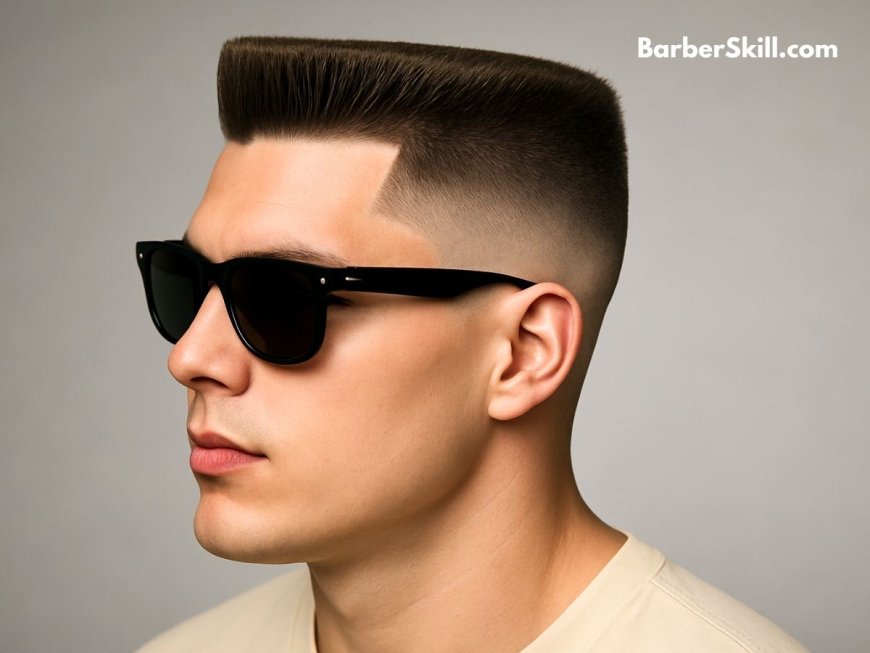
What is a Flat Top Haircut?
A flat top is a men's hairstyle where hair stands upright, forming a flat, level surface across the top. The sides are cut very short using clipper guards for maximum scalp visibility, while the top maintains specific hair length measurements for that distinctive flat appearance. Proper hair styling through barbering techniques requires precise blending techniques and hair density control.
Hey there! I'm Alex Carter, and after 10+ years perfecting men's hairstyles, the flat top haircut remains one of my most requested cuts. Whether it's military personnel wanting that sharp high and tight or civilians seeking masculine grooming trends, this style never goes out of fashion.
In this guide, I'll share 10 popular flat top variations that I've mastered through professional barbering experience. You'll learn barbering terminology, styling requirements, and maintenance tips to keep your cut sharp.
Classic High and Tight Flat Top

The classic high and tight flat top is the grandfather of all military haircuts, featuring an ultra-short horseshoe pattern around the sides and back while maintaining a flat, level surface on top. This precision cutting style creates maximum scalp visibility with sharp lines that scream discipline and authority. The uniform length on top typically measures between half an inch to one inch, creating that signature boxy silhouette that's been a military standard for decades.
To achieve this style, your barber will use various guard sizes, starting with a #1 or #2 on the sides, gradually working up to longer clippers on top, followed by clipper over comb work to create that perfectly flat surface. The key is maintaining those razor-sharp transitions between the short sides and the flat top section. Keep this cut looking fresh with visits every 2-3 weeks, as the sharp lines tend to blur quickly with hair growth.
Flat Top Fade

The flat top fade combines the classic military precision with modern barbering sophistication, blending the short sides seamlessly into the flat top section through expert gradient cutting. This fade haircut variation offers more versatility than the traditional high and tight, with options ranging from mid fade to low fade depending on where the hair transitions begin. The taper fade creates smooth hair transitions that require advanced blending techniques and clipper over comb mastery to achieve that seamless blend from skin to full length.
Your barber will start with shorter guard sizes at the bottom, gradually increasing the length as they work upward, using precise clipper work to eliminate any harsh lines. The flat top section maintains its signature level surface while the faded sides provide a contemporary twist on the classic style. Touch up the fade every 2 weeks to maintain those clean transitions, as fades grow out faster than traditional cuts.
Also read: 15 Best Cristiano Ronaldo Haircuts From 2007 to 2025 With Pics
High and Tight with Skin Fade

The high and tight with skin fade takes military precision to the extreme, featuring a bald fade that transitions from completely shaved skin to the flat top section with sharp contrast and clean lines. This skin fade variation creates the most dramatic look in the flat top family, with zero guard work at the bottom, gradually building to full length on top. The razor work required for this style demands expert, precise fading skills, as the transition from skin to hair must be flawless to avoid any choppy appearance.
To execute this cut, your barber will use clipper blade work starting at the skin level, gradually introducing longer guards as they work toward the flat top section, finishing with detailed razor work for those ultra-clean lines. The contrast between the completely bald sides and the flat top creates an incredibly bold and modern military aesthetic. This high-maintenance style requires weekly touch-ups to keep the skin fade looking sharp and professional.
Flat Top Crew Cut

The flat top crew cut represents the perfect marriage between traditional styling and military precision, offering a conservative length that's ideal for professional appearance in corporate or formal settings. This classic barbering style maintains the signature flat top surface while incorporating the timeless crew cut's tapered sides, creating a look that's both authoritative and refined. The uniform cutting technique ensures consistent length across the top section, typically ranging from three-quarters of an inch to one inch, while the sides gradually taper from longer at the top to shorter toward the neckline.
Your barber will use a clipper over comb work to establish the flat surface, then carefully blend the sides using traditional crew cut tapering methods that create smooth transitions without harsh lines. The key to this style lies in maintaining proper proportions between the flat top section and the tapered sides to achieve that classic, timeless appearance. Schedule maintenance cuts every 3-4 weeks, as this conservative styling grows out more gracefully than ultra-short military variations.
Also read: Top 10 Short Hairstyles for Men Trending in 2025
Curly Flat Top

The curly flat top celebrates natural texture while maintaining the classic flat top silhouette, perfect for guys with coarse hair and defined curl patterns who want to embrace their hair's natural character. This style works exceptionally well with curly hair texture because the natural volume and hair density provide the foundation needed to achieve that signature flat surface without excessive product manipulation. The curl pattern actually helps maintain the flat top shape throughout the day, as the natural spring and bounce of curly hair supports the style's structure better than straight hair textures.
To achieve this look, your barber will use specialized texturizing techniques and ethnic barbering methods, carefully cutting the curls to create an even flat surface while preserving the hair's natural movement and character. The sides are typically cut short to contrast with the textured top, and proper mousse application becomes crucial for definition and hold without weighing down the curls. Maintain this style every 2-3 weeks and invest in quality curl-enhancing products to keep your natural texture looking its best.
Flat Top Recon
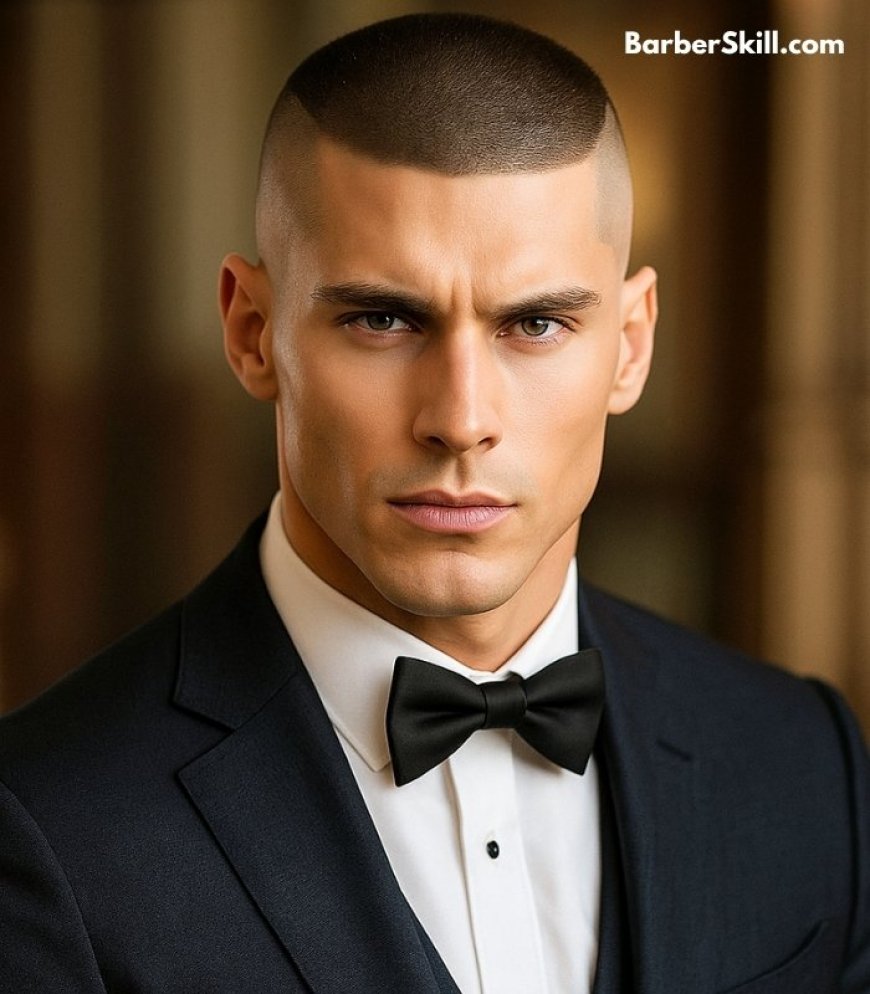
The flat top recon represents the most extreme military specification in the flat top family, featuring an ultra-narrow landing strip of hair on top with ultra-short sides that create the ultimate tactical haircut appearance. This recon haircut takes military precision to its absolute limit, with the flat top section typically measuring only 1-2 inches wide down the center of the head, resembling an aircraft carrier's landing strip. The precise lines and military standard execution make this one of the most demanding cuts in terms of barbering skill, requiring absolute accuracy in measurements and cutting angles to achieve that perfect geometric shape.
Your barber will use the shortest clipper guards on the sides, often starting with a #0 or #1, while carefully sculpting the narrow flat top section using precise clipper work and detailed trimming techniques. The contrast between the nearly bald sides and the thin strip of flat hair creates an incredibly bold and unmistakably military aesthetic that commands attention and respect. This high-maintenance tactical haircut requires weekly touch-ups to maintain those razor-sharp lines and military-grade precision.
Long Flat Top
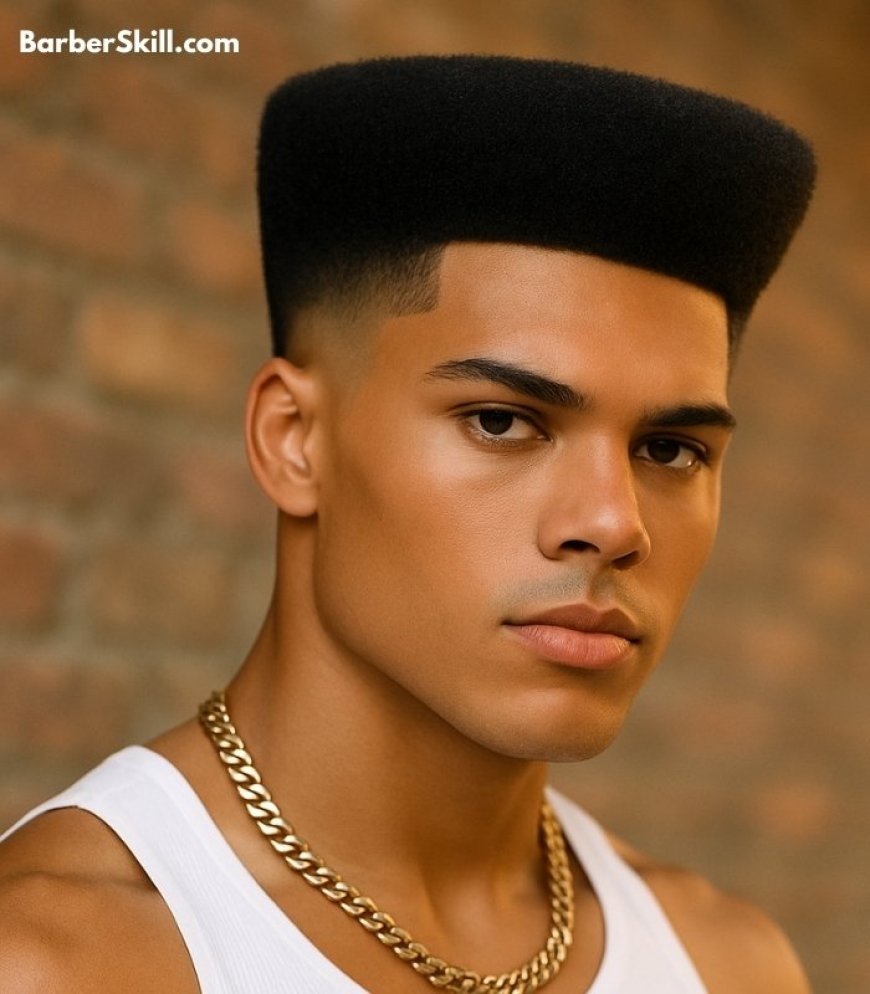
The long flat top pushes the boundaries of traditional military styling by maintaining extended maintenance periods while incorporating a longer length on top, typically 1-2 inches instead of the standard half-inch height. This variation requires strategic use of styling products like hair wax and pomade to maintain the signature flat surface, as the increased length tends to want to fall naturally rather than stand upright. The blow-drying technique becomes crucial here – you're essentially training longer hair to defy gravity and maintain that crisp, geometric top plane that defines the flat top family. In my shop, I've noticed clients who choose this style often want the flat top aesthetic but need something that transitions better into professional environments where ultra-short military cuts might feel too severe.
Your barber will use a clipper over comb work to establish the flat surface, then rely heavily on volume creation techniques during styling to achieve that signature look. Schedule touch-ups every 5-6 weeks since the longer length actually helps maintain shape between cuts, though daily styling with quality products becomes non-negotiable.
Textured Flat Top
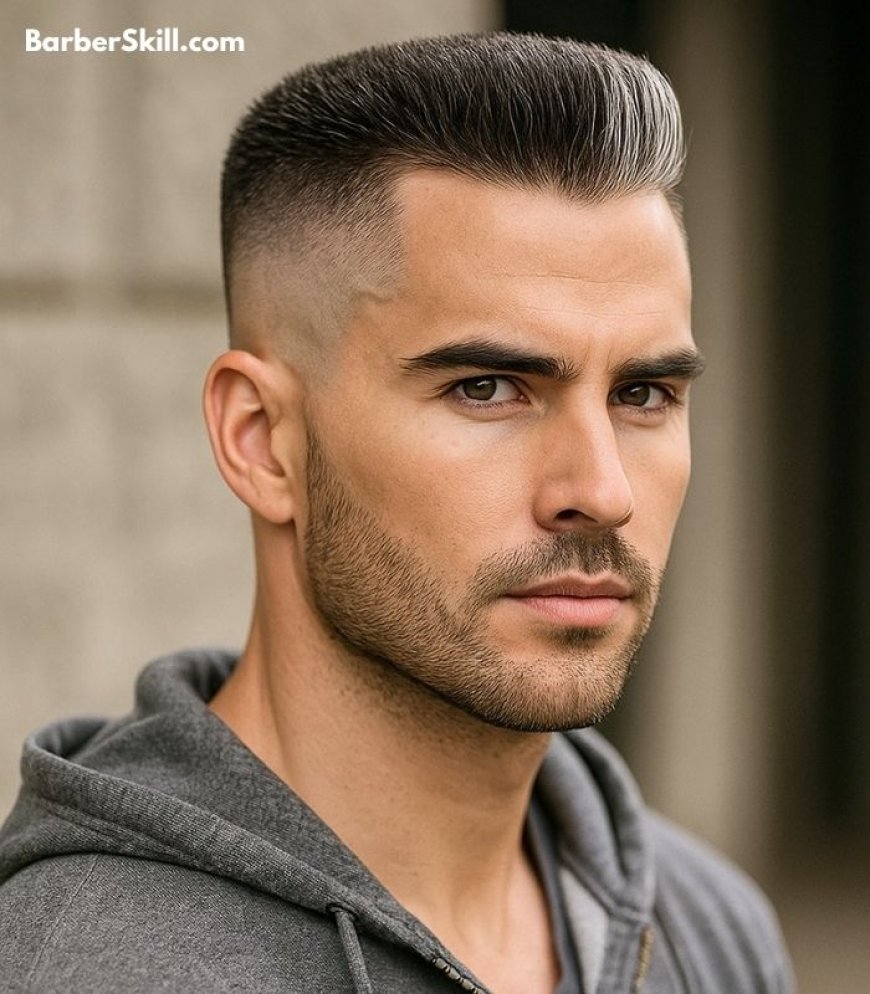
The textured flat top revolutionizes the classic military cut by incorporating choppy layers and natural movement through modern cutting techniques, creating a contemporary styling approach that feels fresh and current. Instead of the traditional uniform surface, this variation uses texturizing shears to create subtle variations in length across the top, giving the hair natural movement while maintaining the overall flat top silhouette. This textured hair approach appeals to guys who want the structured look of a flat top but need something that doesn't appear as rigid or formal as traditional versions.
The beauty of this cut lies in how it bridges classic barbering with contemporary techniques – your barber will establish the basic flat top shape, then use texturizing shears to create those choppy layers that give the style its modern edge. The natural movement created by the texturing actually makes styling easier since the hair wants to work with its natural patterns rather than fighting against them. Book maintenance every 4-5 weeks, as the textured elements help disguise growth patterns better than completely uniform cuts.
Also read: 10 Trending Textured Fringe Haircuts for Men
Flat Top with Fenders

The flat top with fenders represents the pinnacle of traditional barbering, featuring longer sides that extend down past the ears while maintaining the signature flat surface on top, creating that unmistakable vintage appeal of classic styling. These flat top fenders – the longer side hair that frames the face – give this cut its distinctive retro cut character, harking back to the golden age of American barbering when precision and craftsmanship defined every haircut. This style demands serious skill from your barber, as achieving the perfect balance between the geometric top plane and the flowing side sections requires both technical precision and artistic eye. The longer sides need to be carefully blended into the flat top while maintaining their own distinct length and shape, making this one of the most challenging variations in the flat top family.
Your barber will establish the flat top first, then carefully sculpt the fenders to complement the overall proportions of your head and face shape, creating that timeless vintage appeal that never goes out of style. Plan for professional maintenance every 3-4 weeks, as both the flat top and fenders require precise upkeep to maintain their distinct characteristics.
Modern Military Flat Top
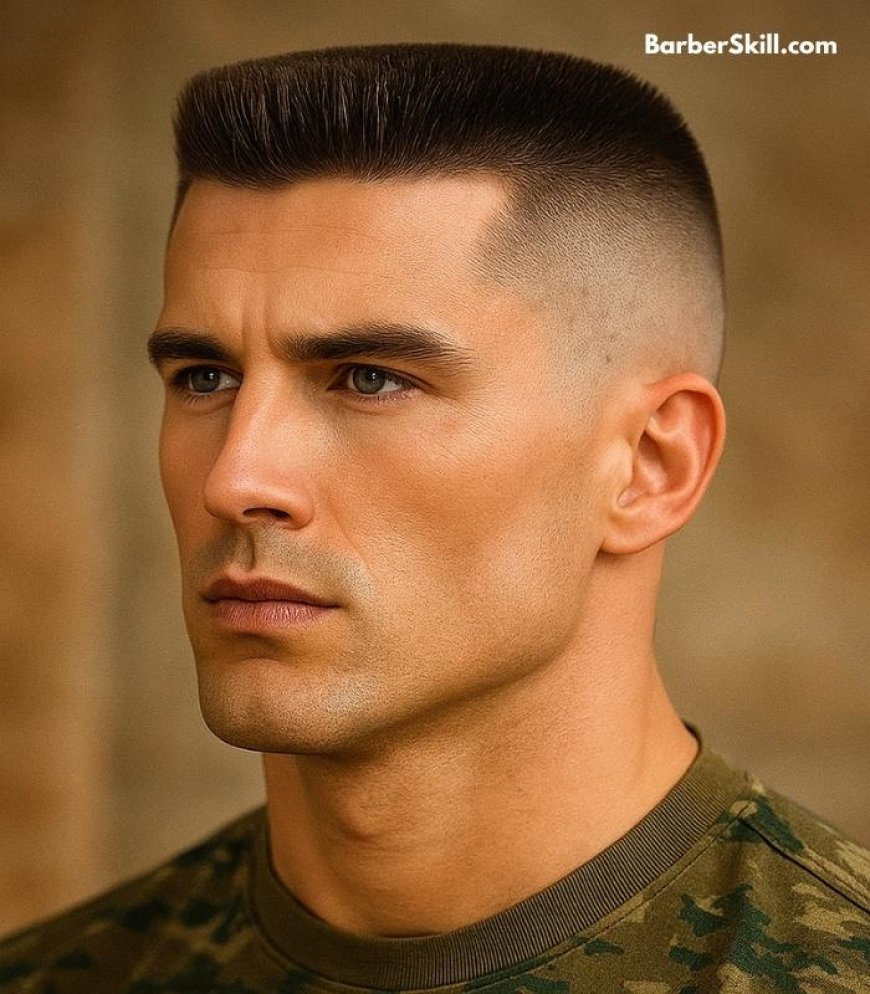
The modern military flat top takes the classic regulation cut and updates it with contemporary techniques, incorporating current regulations while maintaining the clean appearance and professional standards expected in today's military environment. This fresh approach modernizes traditional military grooming by using updated styling methods that create a sharper, more refined look than vintage military cuts, while still meeting the strict guidelines required for active duty personnel. The modern military variation focuses on precision fading, cleaner lines, and more sophisticated blending techniques that weren't available to barbers decades ago, resulting in a cut that looks both regulation-compliant and fashion-forward. Unlike older military cuts that could appear somewhat rough around the edges, this contemporary version emphasizes smooth transitions and flawless execution that reflects modern barbering standards.
Your barber will use current clippers and techniques to create ultra-clean lines and seamless blending, ensuring the cut looks sharp from every angle while maintaining the no-nonsense functionality that military life demands. Schedule maintenance every 2-3 weeks to keep this cut looking regulation-ready, as military standards require consistent grooming that can't wait for longer growth cycles.
Also read: Top 10 Short Hairstyles for Men Trending in 2025
Frequently Asked Questions
How often should I get my flat top trimmed?
Most flat top variations require professional maintenance every 3-4 weeks to maintain their signature shape and clean appearance, though this haircut frequency depends on your individual hair growth rate. In my shop, clients with faster hair growth typically need barbershop visits every 2-3 weeks, while those with slower growth can stretch their maintenance schedule to 4-5 weeks between cuts. The upkeep costs add up, but regular trimming is essential since flat tops lose their geometric precision quickly as hair grows. Unlike other cuts that can look decent while growing out, flat tops either look sharp or they don't – there's no middle ground with this classic style.
What hair type works best for flat top haircuts?
Straight hair and slightly wavy hair work best for flat top haircuts because they naturally stand upright and maintain the signature flat surface without fighting natural curl patterns. Coarse hair with good hair density creates the most dramatic flat tops since thicker strands provide better support for the geometric shape, while fine hair can work but requires more styling products. Curly hair presents the biggest challenge for flat tops, though it's not impossible with looser curl patterns. The key is having enough hair texture and density to support that flat surface, which is why I always assess hair compatibility during consultations before starting any cut.
Can I cut a flat top at home?
I strongly advise against DIY haircuts when it comes to flat tops, as this style requires professional barbering skills, proper clipper technique, and years of experience to execute correctly. Home trimming might seem tempting, but flat tops demand precise clipper over comb work and the ability to create that signature flat surface – techniques that take barbers years to master. Safety considerations become real issues when inexperienced hands attempt complex cuts. One wrong move with the clippers can ruin the entire cut, leaving you with an uneven mess that's expensive to fix. Trust me, I've seen too many flat top disasters after failed home attempts.
What products do I need to style a flat top?
Essential styling products for flat tops include strong-hold hair wax or pomade for shorter variations, while longer flat tops benefit from mousse for volume, followed by gel for lasting hold strength. Product application should be minimal but strategic – work a small amount through slightly damp hair, then use a fine-tooth comb to distribute evenly while creating that flat surface. Hair wax works best for textured flat tops since it provides flexible hold without gel's stiffness, while traditional pomade gives classic shine and firm hold for vintage styles. The key is finding products that provide enough hold strength to maintain shape all day without looking unnatural.
How long does it take to grow out a flat top?
Growing out a flat top typically takes 3-4 months to reach a length where you can transition into other styles, though hair growth rate varies significantly between individuals, and the growing out process requires patience and strategic barber guidance. Most guys experience an awkward phase around week 6-8 when hair is too long for the flat top shape but too short for other styling options. I usually recommend intermediate transition styles that gradually soften the geometric lines while working toward your target length. The key is working with your barber throughout the process, scheduling appointments every 4-5 weeks to shape growth and avoid that dreaded helmet head stage.
What's the difference between a high and tight and flat top?
The main difference between high and tight vs flat top cuts lies in the top section – high and tight features very short hair all over with minimal length variation, while flat tops maintain longer hair on top cut to create that signature flat, geometric surface. High and tight represents a more extreme military haircut with sides and back buzzed to skin and top kept around a #1 guard, focusing on maximum convenience. Flat tops require more sophisticated cutting techniques and styling since creating that flat surface demands precision clipper work. In appearance comparison, high and tight looks more severe and utilitarian, while flat tops offer more visual interest despite both being military-inspired cuts.
Which face shapes suit flat top haircuts?
Flat top haircuts work exceptionally well with square faces and oval faces since the geometric top section complements angular facial features and creates excellent proportion balance. Round face shapes can wear flat tops successfully, but I recommend keeping sides shorter and top height moderate to avoid adding width that emphasizes roundness. The key with face shape compatibility is understanding how flat top's horizontal lines interact with your natural facial structure. During consultations, I always consider styling recommendations based on individual facial features, ensuring the flat top enhances rather than conflicts with natural bone structure for the most flattering result.
How much does a professional flat top haircut cost?
Professional flat top haircut prices typically range from $25-60, depending on your location, the barbershop's reputation, and the complexity of the specific variation you're getting, making this a solid value investment for a classic style. Barbershop costs vary significantly between small towns and major cities, but expect to pay on the higher end since flat tops require advanced professional services and specialized skills that not every barber possesses. The initial cost might seem steep compared to basic buzz cuts, but a well-executed flat top maintains its shape longer than many other cuts. I always tell clients that investing in a skilled barber pays dividends in both appearance and longevity.






